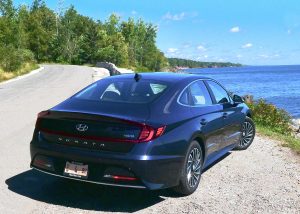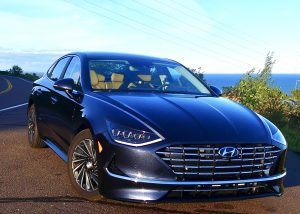High-tech Sonata adds higher-tech Hybrid
Filed under: Weekly test drives, Autos
By John Gilbert
As Yogi Berra might have said, if he looked out my kitchen window at the shiny new Hyundai Sonata awaiting me: “It’s deja vu all over again.”
It’s OK to quote Yogi, because faithful readers will note that I only recently had written about the newly redesigned 2020 Sonata, which gave us amazing fuel economy in the 40s on a trip across Minnesota, from Duluth to Brainerd and back. I loved the car, so I wasn’t upset when another one — a beautiful dark blue instead of the silver first one — was delivered. I was, however, curious to get a second Sonata so quickly. As I walked a full circle around the car, I got to the rear deckled, finally, and noticed one extra word on the right side: “Hybrid.”
Suddenly I understood, and looked forward to every second I could spend behind the wheel of that Sonata Limited Hybrid. Hyundai always likes to prove it can punch above its class, and the Sonata Hybrid might set new standards for bargain production. The base Sonata Hybrid starts at $35,300, and you have to add all sorts of options, like the Bose audio upgrade, the solar roof, and the inside ambient lighting, to get that sticker up over $40,000.That makes the non-hybrid Sonata a distinct bargain, but the Hybrid shares its dramatic lines and offers the highest of high-tech.
For the sticker price, you get the kind of gas mileage you want to write home about. The EPA estimates start with a city figure of 45 miles per gallon, with 51 in highway driving, for an overall average of 47. I am here to tell you that you can meet those figures if you drive the car hard, and if you drive judiciously you can easily surpass them. We found that, like most hybrids, you get better fuel economy in city driving, where you exploit every bit of electric energy. On the freeway, holding a steady 70 or 75, the gas engine will be working steadily, which uses more fuel.
We got 46.7 mpg on a trip from Duluth to Minneapolis and back, and the next day, driving up and down the hills of Duluth, I got it up to 62.1 mpg, a figure I found hard to believe. Read more




 John Gilbert is a lifetime Minnesotan and career journalist, specializing in cars and sports during and since spending 30 years at the Minneapolis Tribune, now the Star Tribune. More recently, he has continued translating the high-tech world of autos and sharing his passionate insights as a freelance writer/photographer/broadcaster. A member of the prestigious North American Car and Truck of the Year jury since 1993. John can be heard Monday-Friday from 9-11am on 610 KDAL(www.kdal610.com) on the "John Gilbert Show," and writes a column in the Duluth Reader.
John Gilbert is a lifetime Minnesotan and career journalist, specializing in cars and sports during and since spending 30 years at the Minneapolis Tribune, now the Star Tribune. More recently, he has continued translating the high-tech world of autos and sharing his passionate insights as a freelance writer/photographer/broadcaster. A member of the prestigious North American Car and Truck of the Year jury since 1993. John can be heard Monday-Friday from 9-11am on 610 KDAL(www.kdal610.com) on the "John Gilbert Show," and writes a column in the Duluth Reader.